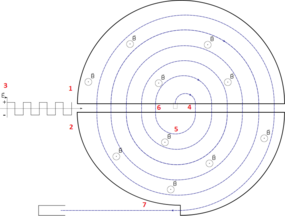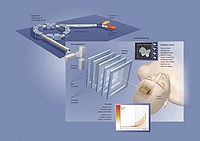Cyclotron
Created by Raymond Han(rhan36)
First invented and created in 1932 by inventor Ernest O. Lawrence, the cyclotron was considered to be an invention that would produce images of charged particles accelerating outwards from the center to form about a spiral path. The cyclotron was also known to be one of the earliest types of particle accelerators before the introduction of the synchrotron. Although the cyclotron may have been outdated with the introduction of new ideas and inventions, it was still used to produce particle beams in physics. The functionality of the cyclotron is best described as moving charges and bending these moving particles into a semicircular path that come from a magnetic force. We begin to understand the importance of the cyclotron when we define what magnetic force means on a moving charge. The magnetic force provides the centripetal force, any motion in a curved path that represents an accelerated motion, and requires force directed toward the center of the path, to bend the moving charge into a circle of radius (X). Since we have begun to have a better understanding of the importance of the cyclotron, Lawrence has allowed us calculate the frequency of the acceleration of moving charges.

The Main Idea
The idea that a magnetic field perpendicular to the plane of motion will create a particle along a curved path was the first notion for the creation of the cyclotron. Lawrence wanted to measure the acceleration that the particle will have about a curved path and the relation that an increase in radius of a path will have on the velocity/acceleration of the moving charge. Using two hollowed sheet metals, otherwise known as 'dees', the cyclotron accelerates a beam of charges onto them. The 'dees' applies a static magnetic field, B, as the beam is applied to them. Doing so, the magnetic field is bent about the circular shape of the 'dees' in accordance to the Lorentz force.

A Mathematical Model
The centripetal force is simplified by the transverse magnetic field B. The cyclotron can only accelerate to speeds slower than the speed of light. Thus, for non relativistic particles, the centripetal force to keep them aligned on the curved path is: [math]\displaystyle{ \frac{mv^2}{r} = Bqv }[/math]
The speed at which the particles enter the cyclotron due to a potential difference, V, is: [math]\displaystyle{ v = \sqrt{\frac{2Vq}{m}} }[/math]
Since v/r is equal to angular velocity, w, so [math]\displaystyle{ \omega = \frac{Bq}{m} }[/math]
Angular frequency is [math]\displaystyle{ \omega = {2\pi} f_c }[/math]
This all equals the speed at which the particles enter initially : [math]\displaystyle{ f_c = \frac{Bq}{2\pi m} }[/math]
This is all to say that the particle of constant mass does not depend upon the radius of the orbit. Deriving the equations for angular frequency to see the speed at which the particles enter, the particles require additional mass and requires change in frequency or magnetic field to derive the acceleration.
Applications of cyclotron
Cancer
For several decades, cyclotrons have seen the most usage in the broad topic of nuclear physics. Primarily, cyclotrons are efficient in treating cancer since we can focus on particles that are cancerous within the body. This is also known as particle therapy where the ion beams can use protons to penetrate the body and kill any tumors. More and more, cyclotrons are being incorporated into hospitals to combat cancer because of this particle therapy.

NASA
In order to find safer and less expensive means of space travel NASA has proposed the idea of launching payloads in to orbit using a two mile long railgun. The process would prove much safer for astronauts by taking out the highly explosive rocket fuel currently used to propel them into orbit, and for the same reason it would be a faction of the cost since the energy required would be significantly less. Another bonus is the flexibility that would be allowed. As opposed to current rockets which could never be launched on consecutive days, a railgun would allow another launch as soon as there was enough potential in the batteries.
Connectedness
- How is this topic connected to something that you are interested in?
Like most Tech students I am interested in all of the newest technologies and their variety of applications. Both the implications on the military side and space travel side are fascinating and could easily influence our lives and certainly the lives of future generations.
- How is it connected to your major?
As a Computer Engineering major there are many connections with electromagnetics in my major. Specifically there will be many connections with the hardware and software components of any railgun which is what I am specifically interested in.
- Is there an interesting industrial application?
The idea of commercial space travel could be greatly helped out by the advent of a railgun which would launch customers in to orbit for much cheaper than is now imaginable.
History
The physics behind a railgun and the Lorentz Force has been known many years since Oliver Heaviside discovered in it 1889, five years before Hendrik Lorentz derived it. In 1919 frenchman Louis Octave Fauchon-Villeplee filed the first U.S. Patent for a rail gun type device calling it an "Electric Apparatus for Propelling Projectiles." However only in recent decades has it been a practical option for much of anything due to the large amounts of potential and current it requires to produce a meaningful force. The United States Navy for example started heavily researching the capabilities of the railgun due to their new Zumwalt-class Destroyer which can produce 78 megawatts of power when it only needs 20 megawatts to operate, leaving 58 for the requirements of the railgun.
References
http://www.onr.navy.mil/media-center/fact-sheets/electromagnetic-railgun.aspx
http://www.popsci.com/article/technology/navy-wants-fire-its-ridiculously-strong-railgun-ocean
http://www.google.com/patents/US1421435?dq=Fauchon-Villeplee